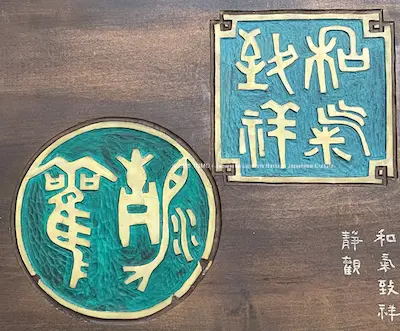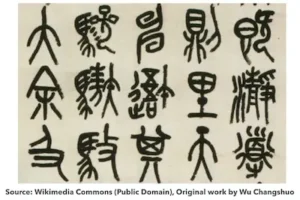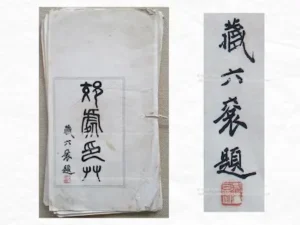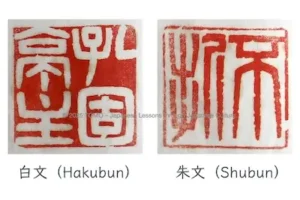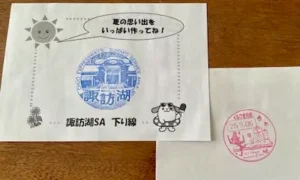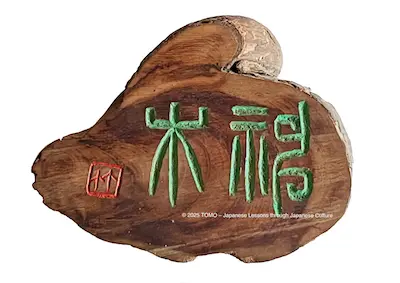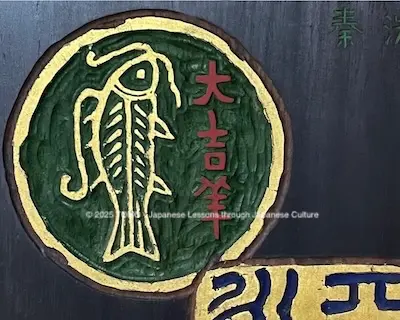Digital Color Restoration: Kōshō’s Art Reborn and its Hidden Meaning
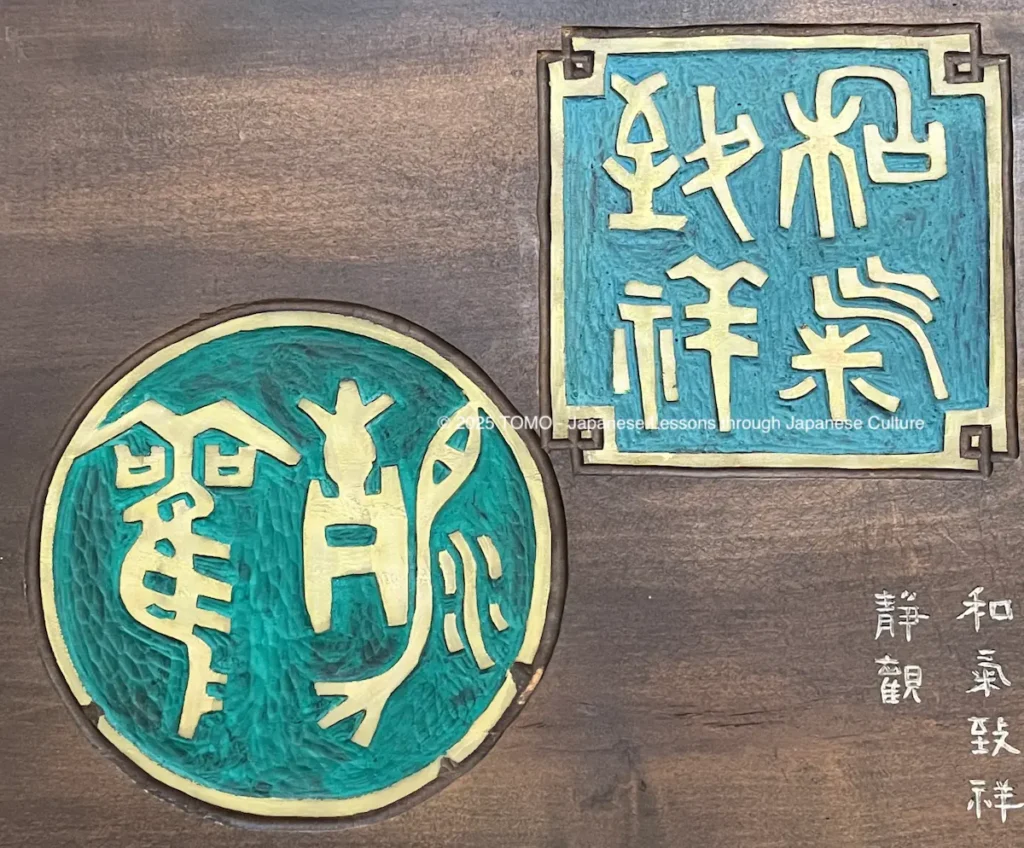
Among the works left behind by my ancestor, 竹邨 (Chikuson), there is a beautiful seal carving plaque.
It was made to celebrate a special occasion.
A seal carving plaque is a piece of wood engraved with traditional seal characters, often made as a gift or decoration for joyful occasions.
Restoring an Ancestral Seal Carving
This particular artwork was created about 80 years ago.
Over time, its colors softened with age. Now, through digital restoration, it has regained its original brilliance.
Because the artwork is large and the digital process takes time, this restoration focuses on just one section
— the part that reads “年製紀祥 (Nensei Kishō)”.
H3: Focus on “Nensei Kishō”
It is read in order: top right → bottom right → top left → bottom left.
On the left side, there is an engraving that visually expresses the meaning of “Nensei Kishō.”
This phrase was created by my ancestor.
Each character carries deep meaning, and together they form a special expression that celebrates life and happiness.
The white characters on the lower right read “Wakichishō” (和氣致祥) and “Seikan” (静観).
“Wakichishō” means “a gentle and harmonious spirit brings happiness.”
“Seikan” means “to observe calmly and see things with a peaceful mind.”
Both phrases express a wish for peace and happiness, reflecting the sentiment of the entire work.
The Meaning Behind the Seal Carving Plaque
Each of the four kanji characters carries a special meaning:
- 年 (nen): year, time, or era
- 製 (sei): to create or make
- 紀 (ki): to record or chronicle
- 祥 (shō): good fortune, blessing, or happiness
Together, they express a deeply positive wish:
“To create and record a joyful event in a specific year.”
In other words, this phrase conveys a message of good fortune and celebration.
It symbolizes the creation of something auspicious to mark a memorable time.
Digital Restoration and the Story of Colors
The Pigments Used at the Time
The colors inside the frame of this artwork cannot be exactly reproduced using modern pigments.
Therefore, it is believed that the artist mixed three pigments that were readily available at the time: Rokusho, Ultramarine, and Gofun.
Each pigment has its own characteristics:
- Rokusho (copper-based green-blue): A blue-green pigment with a hint of green. It gives a sense of stability and calmness.
- Ultramarine : A vibrant, slightly purple-tinged blue. It adds depth, transparency, and a sense of stability.
- Gofun (shell-based white): A white pigment made from crushed shells. It reflects light and adds brightness and softness to the colors.
Color Characteristics of the Artwork
- Background of the right characters: greenish-blue
- Background of the left illustration: bluish-green
I made the color around the text slightly darker.
Before and After
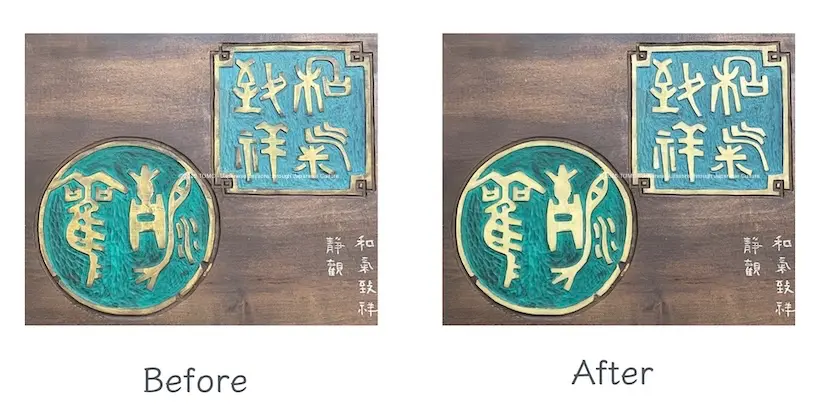
- Before: The original artwork had softened over the years. The wood grain and impressions appeared calm. This was not mere deterioration, but a warm expression of the time the artwork had lived through.
- After: The gold sections were restored by layering gold. The wood grain was preserved while bringing back the original brilliance of the gold.
I enhanced the colors to make them more vivid and solid.
Restoration of the Gold Sections
The gold was originally applied as gold leaf. Over time, it became thin and the wood grain showed through. Therefore, the gold was carefully reapplied.
Key point: The gold was applied without covering the wood pattern (growth rings), preserving the texture.
This restoration made the artwork feel brighter and more vivid.
It brought out the colors’ charm, reviving the artwork closer to its original state.
The Warm Thoughts Behind the Artwork
This seal carving plaque was created by my ancestor to celebrate a family occasion.
Because it was made with care over time, each character and color carries their heartfelt intention.
The phrase “Nensei Kishō” carved on part of the plaque means:
“To create and record a joyful event in a specific year.”
It reflects the spirit of blessing and celebration.
When the colors were digitally restored, the ancestor’s wishes seemed to come alive again.
The subtle variations of Rokusho, Ultramarine, and Gofun highlight the delicate colors of the plaque.
The brilliance of the gold leaf adds a shimmering accent.
Together, they convey not only beauty but also a sense of good fortune and hope for the future.
This plaque is more than just an artwork.
It tells a warm story of family love and happiness, speaking to us even today.
The Meaning of Kanji and Cultural Depth
From a Japanese language teacher’s perspective, each kanji character carries its own meaning.
For example, in “Nensei Kishō”, the kanji express time, creation, record, and blessing.
By combining them, they convey heartfelt wishes and a story.
In contrast, hiragana or katakana alone cannot convey such subtle meanings or cultural nuances.
In my culture course, students not only learn vocabulary and grammar.
They also explore the richness of Japanese culture and thinking through the meanings embedded in kanji.
Conclusion
Through this digital restoration, the colors have regained their original vibrancy.
The combination of the bright colors and the meaning of the characters gives the artwork a lively and vivid impression.
Moreover, it conveys, across time, the depth of the Japanese language and the richness of Japanese culture and thought.
For further insights into seal carving and my ancestor’s works,
check “Unlocking the Art of Japanese Seal Carving: The Story Behind an Ancestor’s Carved Seal
Japanese of the Day / 今日の日本語
- Word:金箔 (kinpaku) – gold leaf
- Meaning:Thin sheets of gold used for decoration, art, or gilding.
- Example:この仏像には金箔が貼られています。(Kono butsuzō ni wa kinpaku ga harareteimasu.)
(This Buddha statue is covered with gold leaf.) - Fun Fact:Kinpaku is often used in Japanese traditional crafts. Applying it to buildings, crafts, or lacquerware adds a beautiful shine.
◆ Would you like to talk about Japanese culture? ◆
In the Culture Course, you can learn to speak about Japanese culture with me.
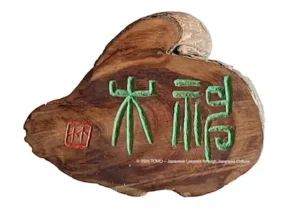
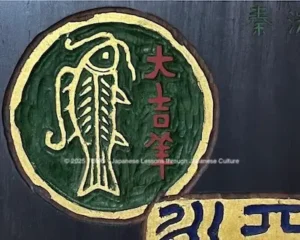
作品との再会
先祖の残した作品の中に、お祝いのために作られた篆刻額があります。
「篆刻額」とは、木の板に篆刻されたものです。主にお祝いの贈り物、飾りものとして使われました。
こちらの作品は、約80年前のものです。長年の時を経て、その色彩は落ち着いた味わいを帯びていました。
そして、今回デジタル修復で再び輝きを取り戻しました。
この作品は大きく、デジタル作業にも時間がかかるため、今回は作品の一部に焦点を当てています。
右側には「年製紀祥(ねんせいきしょう)」と刻まれています。読む順番は 右上 → 右下 → 左上 → 左下 です。
そして、左側には「年製紀祥」を表す絵が刻まれています。
この言葉は先祖による造語で、漢字一つ一つに意味が込められています。
四つの漢字を組み合わせることで、全体として特別な意味を表現しています。
右下の白文字の漢字は「和氣致祥(わきちしょう)」「静観(せいかん)」と刻まれています。
「和氣致祥(わきちしょう)」は「和やかな気持ちが幸福を招く」という意味で、
「静観(せいかん)」は「静かに見守る」「心を落ち着けて物事を観る」という意味です。
どちらも穏やかな心と幸せを願う言葉であり、作品全体の思いを表しています。
篆刻額に込められた意味
この四つの漢字には、以下のような意味が込められています:
- 年(ねん):歳月、一年、時代
- 製(せい):作る、製造する、定める
- 紀(き):記す、記録する、しるし、時代、年号
- 祥(しょう):めでたい、吉兆、幸福、幸運
この部分全体の意味は、
「特定の時(年)に、めでたいこと(祥)を記録(紀)し、作り出す(製)」 という、とてもポジティブな願いが込められた言葉です。
つまり、「記念となる年に、幸運や吉兆を制作する/もたらす」 という縁起の良いメッセージになります。
デジタル修復と色彩の物語
当時の顔料について
この作品の枠の中の色は、一つの顔料そのままでは再現できないと考えられます。
そのため、当時入手しやすかった緑青・群青・胡粉の三色を混ぜて作ったのではないかと考えました。
それぞれの顔料の特徴は以下の通りです:
- 緑青(ろくしょう):銅を原料とした青緑色の顔料。緑みの青で、安定感と落ち着きを感じさせる色。
- 群青(ぐんじょう):鮮やかでやや紫寄りの青。深みと透明感があり、安定感と落ち着きを与える。
- 胡粉(ごふん):貝殻を原料とした白色顔料。光を反射させ、色に明るさや柔らかさを加える。
作品の色の特徴
- 右側の文字の背景:緑寄りの青
- 左側の絵の背景:青みの緑
→ 文字の周りの色を少しだけ濃くしました。
ビフォー・アフター
- Before:修復前の作品。長年の時を経て木肌や印影は落ち着いた色合いに。
単なる劣化ではなく、作品が歩んできた時間を感じさせる温かい表情。 - After:金色の部分を重ねて修復。木目を残しつつ金箔の輝きを取り戻しました。
色を鮮やかにして、しっかりした印象にしました。
金色部分の修復
- 金色は金箔を貼り付けてあります。
- 長い年月の経過で薄くなり、背景の木目が透けていたため、金色を重ねて修復しました。
→ 修復のポイントは、ベタ塗りせず、木の模様(年輪)を消さずに残したことです。
このように修復したことで、作品全体が明るく生き生きとした印象になり、色彩の魅力がより一層引き立ちました。
当時の状態がよみがえったのではないでしょうか。
作品に込められた温かい想い
この篆刻額は、先祖が家族のお祝いのために作った作品です。
時間をかけて作られたため、文字や色彩にその想いが込められています。
額の一部に刻まれた「年製紀祥」には、特定の時(年)に、めでたいこと(祥)を記録(紀)し、作り出す(製)という意味があります。
そこには祝福の心が表れています。
デジタル修復で色彩が鮮やかさを取り戻すと、先祖の願いまでも蘇ったかのように感じられました。
緑青や群青、胡粉の微妙な色の違い、そして金箔の輝きは、単なる美しさだけでなく、幸運や未来への希望を伝える力を持っています。
この篆刻額は、単なる美術作品ではなく、家族への愛や幸福を願う温かい物語として、今も私たちに語りかけてくれます。
漢字に込められた意味と文化の深さ
日本語教師の視点から見ると、日本語では漢字一つひとつに意味が込められています。
例えば、この篆刻額の「年製紀祥」も、漢字それぞれに時・制作・記録・祝福の意味があります。
その漢字を組み合わせることで、温かい願いや物語を表現しています。
一方、ひらがなやカタカナだけでは、このような細やかな意味や文化的なニュアンスを伝えることはできません。
私の文化コースでは、単語や文法を覚えるだけでなく、漢字の持つ意味を通して、日本の文化や考え方の豊かさを学ぶことを大切にしています。
まとめ
今回のデジタル修復で、色彩が鮮やかさを取り戻しました。
色の輝きと文字の意味が合わさることで、作品全体が生き生きとした印象になりました。
そして、時代を超えて、日本語の奥深さや、日本の文化や考え方の豊かさを私たちに伝えてくれます。
篆刻の世界や先祖の作品の詳細は、「Unlocking the Art of Japanese Seal Carving: The Story Behind an Ancestor’s Carved Seal」をご参照ください。

